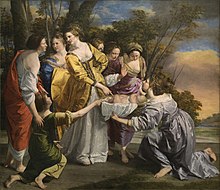
The"' Finding of Moses'", sometimes called "'Moses in the Bulrushes'", "'Moses Saved from the Waters'",[1] or other variants, is the story in chapter 2 of the Book of Exodus in the Hebrew Bible of the finding in the River Nile of Moses as a baby by the daughter of Pharaoh. The story became a common subject in art, especially from the Renaissance onwards.
Depictions in Jewish and Islamic art are much less frequent, but some Christian depictions show details derived from extra-biblical Jewish texts. The earliest surviving depiction in art is a fresco in the Dura-Europos synagogue, dating to around 244. The motif of a "naked princess" bathing in the river has been related to much later art. A contrasting tradition, beginning in the Renaissance, gave great attention to the rich costumes of the princess and her entourage.
Moses was a central figure in Jewish tradition and was given various significances in Christian thought. He was regarded as a typological precursor of Jesus. He could also, at times, be regarded as a precursor or allegorical representation of things as diverse as the pope, Venice, the Dutch Republic, or Louis XIV.
The subject also represented a case of a foundling or abandoned child, a significant social issue in modern times. The subject is unusual in standard history painting in that it requires a number of female figures, but apart from the baby, no male figures are necessary. Many painters took the opportunity to depict female nudes.

- ^ This is standard in the Romance languages, eg "Moïse sauvé des eaux" is the standard title in French.